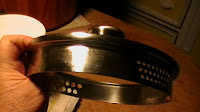
Monday, Monday.....
Life's been busy, crazy and even slightly hair-raising at times....and this is just the beginning of the week. OY!
Jack's been feeling under the weather, so we've been going to doctors and sitting in waiting rooms a lot. OY again! So tonight for dinner I wanted to make one of our favorite things....Orange Chicken Stir Fry with Rice.
There are several versions of this dish...some are just chicken cut in pieces, dredged in seasoned flour and/or corn starch, stir fried then re-stirred with peppers and onions in an orange sauce. That's fine and good. But I didn't want anything complicated. It had to be simple, quick and tasty.
So I took some chicken thighs (conveniently defrosted), skinned, rinsed then patted them dry. I decided to leave them whole for the first portion of their cooking. Partially because I wanted to retain the moisture and partially because I was being just plain lazy.
Anyway, these chicken pieces went into a bowl containing orange juice and bits of cut up garlic, ginger and onion (finely chopped-and you don't need a lot and could probably substitute dried spices for chopped from fresh). I set it aside to marinate while preparing everything else.
The rice was easy enough...for review- one cup of rice, 1 tablespoon of butter or margarine, two cups of water. Butter cook the rice in the pan a few moments before adding the water, then bring it all to a boil before covering it for 20 minutes. NO PEEKING! After 20 minutes, remove it from the heat but don't remove the lid for an additional 5 minutes. When you do, the rice will be perfect.
After assembling all the tools, spices and so on, it was time for some serious chopping! I believe there's a natural order to things....be it cooking or rocket science (by the way, the two are NOT mutually exclusive, leastways not to my way of thinking!). In cooking, I make sure the things that are going to take longest to cook get started first.
I cut up the broccoli and carrots first, cut sugar peas into small bits, then red bell peppers, onions, garlic, a bit of bok choy and some oranges so that everything would be ready to grab.
 |
| Veggies in the wok |
The wok had been dry heating (no oil in it) for a little while over a low flame. Once everything was ready, I turned up said flame to maximum and put about 2 teaspoons of oil into it, swirling the pan carefully to spread it around. To that I added the broccoli and carrots, stirring and stirring all the while.
Some folks like to pre-steam their "hard" veggies before wokking them. I used to do that, too. But in I've found cooking them in the wok retains their nutritional value, flavor, texture and color. After cooking the broccoli and carrots for about 3 to 5 minutes, I added the cut sugar peas, peppers, cut up white portions of bok choy(the leaves will come later and are optional), a bit of the garlic ginger and some onion.
That was all stir fried for another few minutes,then I tested a piece of broccoli and carrot.
NOTE: They should still have a bit of a crunch to them
 |
| Chicken cooking in wok |
I poured all this into a metal bowl and set it aside....it was time to address the chicken thighs, which had been soaking a good 30 to 40 minutes by now. After bringing the wok back up to heat and giving it a light sheen of oil, I added the whole pieces "skin side" down. I spooned a bit of the marination into the wok too, and let the whole thing cook for five minutes on side one and five minutes on side two. Then I set them aside to rest.
The marination liquid was still usable. Two tablespoons of cornstarch, a splash of balsamic vinegar (just a splash) and a teaspoon of light brown sugar turned it into a good sauce.
I got a small skillet and zapped it with some release spray (like Pam, etc.) then added the sliced oranges and stir fried them 'til they began to brown.
 |
| Oranges cooking in skillet |
After cutting up the chicken, I added the oranges and the chicken to the wok and stir fried all of that, with a little of the sauce mixture. When it started to thicken, I added the remaining veggies and stirred the whole thing around until it was well blended. I added more of the sauce mixture, a little at a time, until the consistency was just right. Then I adjusted the seasonings, put it over rice and served it to Jack, who was very happy.
 |
| Orange Chicken Stir Fry |
There are lots of different things you can do with this base recipe. If I were serving it to myself, I'd add some little hot red chili peppers....but that's me. I eat fire.
So that's how I get out of the Monday blues....a little kitchen creativity.




































